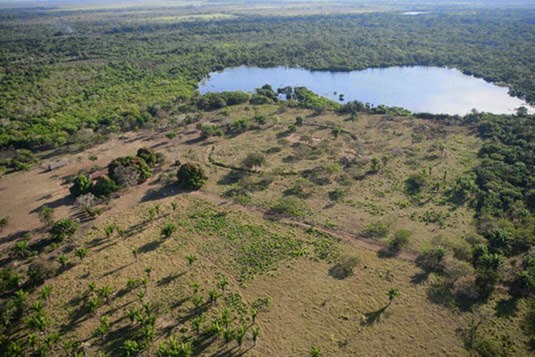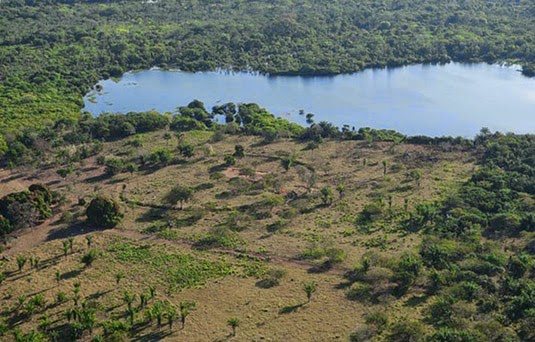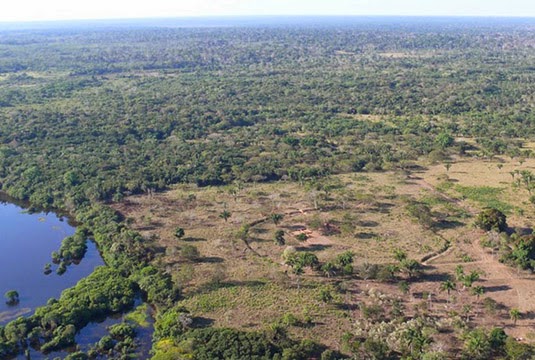 [Image: Photo by Heiko Prumers, courtesy of LiveScience].
[Image: Photo by Heiko Prumers, courtesy of LiveScience].
The remains of artificial structures that pre-date the Amazon rainforest have been found beneath the trees in Bolivia and Brazil. The forest actually grew up and around their ruins, we read, gradually consuming these structures altogether as the rainforest we see there today slowly spread over hundreds of years and conquered the landscape.
“A series of square, straight and ringlike ditches scattered throughout the Bolivian and Brazilian Amazon were there before the rainforest existed,” LiveScience reported earlier this month.
Based on the research of a postdoctoral graduate student named John Francis Carson, the report suggests that “the diggers of these ditches created them before the forest moved in around them. They continued to live in the area as it became forested, probably keeping clear regions around their structures.”
 [Image: Photo by Heiko Prumers, courtesy of LiveScience].
[Image: Photo by Heiko Prumers, courtesy of LiveScience].
One of the most intriguing suggestions of the study is that the rainforest we see there today is actually, at its origins, what Carson calls “a coproduction between humans and nature.”
“It’s very likely, in fact,” he explains, “that people had some kind of effect on the composition of the forest… People might favor edible species, growing in orchards and things like that, [or] altered the soils, changing the soil chemistry and composition, which can have a longer-lasting legacy effect.”
In other words, the deliberate, long-term selection and cultivation of plant species preferred by humans would have led to a distinct type of forest growing in the region, not just a “wild” expanse of whatever plants could naturally survive.
The ancient forest was pruned, tended, and gardened, Carson’s research suggests, and therefore has a kind of unnatural origin, not unlike an abandoned garden gone to seed.
 [Image: Photo by Heiko Prumers, courtesy of LiveScience].
[Image: Photo by Heiko Prumers, courtesy of LiveScience].
In fact, this brings to mind the fascinating work of UC Berkeley anthropologist Christine Hastorff, who has pointed out that many of the heavily vegetated Central American landscapes we inaccurately and over-simplistically describe as “rainforest” are actually “feral gardens“: plots of artificially cultivated plants, vines, and trees, similar to orchards, that only later took on the appearance of wilderness after their gardeners were exterminated by Europeans.
Hastorff—like Carson—suggests that traces of this human-induced artificiality at the scale of an entire ecosystem can still be detected in the landscape, following detailed investigations into what combinations of plants grow in what areas, and then comparing these to what we would expect to see growing without human interference. These landscapes are not really wild forests at all, then, Hastorff explains, but “Maya village community garden plants that have gone feral. That isn’t the forest that was there before humans landed in the Americas.”
In any case, Carson’s work on the “mysterious earthen rings” found beneath the tree cover of the Brazilian and Bolivian Amazon is certainly fascinating for its glimpse of human settlement patterns—that is, architecture—hidden beneath an incredible landscape. However, its even more intriguing take away is that this very landscape was—at least in part—cultivated and influenced by the people who built the “earthen rings” we see in these photographs. Developing the implications of this “has only just started,” he tells LiveScience.

I love this. A lot of Amazon research also appears in Charles C. Mann's 1491: New Revelations of the Americas Before Columbus.
This is also true of the Australian bush which is often mistaken for wilderness but was described by early explorers as like riding through a park, the result of tens of thousands of years of firestick farming.
Jeremy, there's an anthropologist named Clark Erickson who's done a lot of great research along these sort of themes, as well; we should talk about this stuff next time we meet up in LA.
Ian, great to see you here! When I was down in your neck of the woods a few years ago—when we met in Sydney—I was reading Tim Flannery's book The Future Eaters, which remains one of my top 50 or so landscape / natural history books. The stuff in there on long-term effects of aboriginal land management is totally fascinating, especially the material on fires. Hope all's well with you, meanwhile; thanks for the comment.
I've been reading just not commenting, very busy, had an accident plus two big institutional exhibitions, one about an agriculturalist PA Yeomans, the main forerunner of permaculture. Farming as landscaping, might interest you. http://yeomansproject.com/finally-after-so-many-years/
Congrats – looks great. Hope the accident wasn't too serious, meanwhile – stay safe!